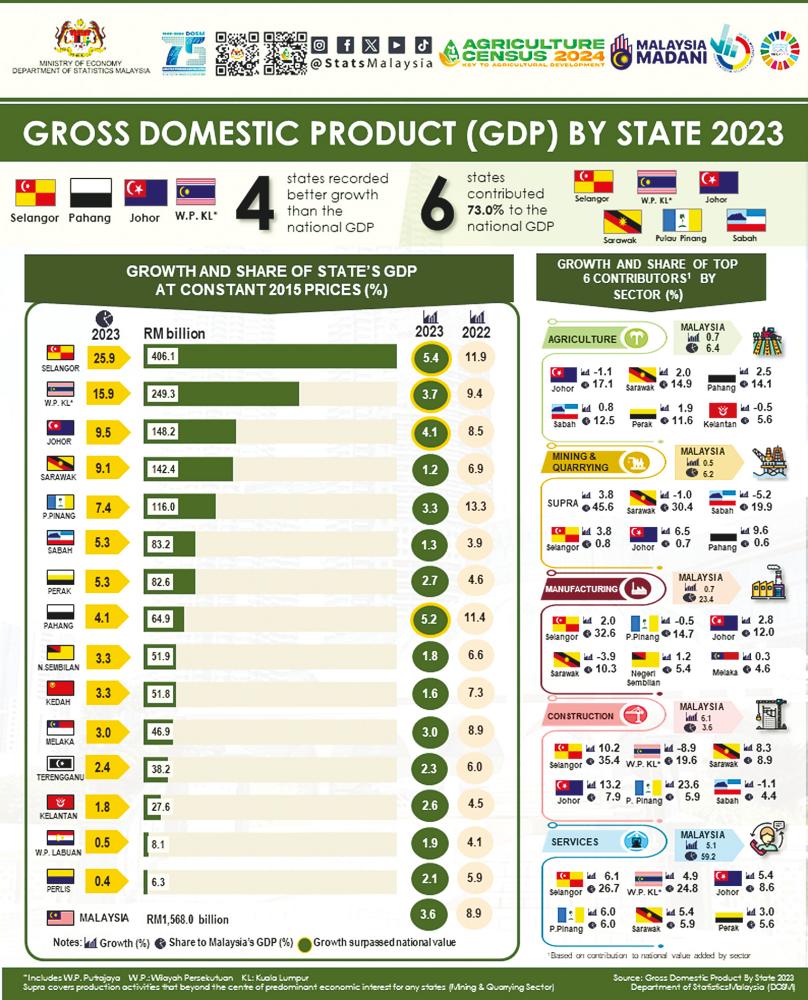PETALING JAYA: Malaysia’s economy expanded by 3.6% in 2023, registering gross domestic product (GDP) of RM1.6 trillion.
According to the Department of Statistics Malaysia, the services sector continued to be the driving force of the national economy, contributing 59.2% with growth of 5.1% last year compared with 2022. Within the same period, the manufacturing sector, holding its position as the second largest contributor to GDP, experienced modest growth of 0.7%.
Similarly, the agriculture and the mining & quarrying sectors experienced moderate growth of 0.7% and 0.5%, respectively. The construction sector sustained its momentum, achieving continued growth of 6.1%.
Chief Statistician of Malaysia Datuk Seri Dr Mohd Uzir Mahidin said, “At the state level, four states surpassed the national growth rate which were Selangor at 5.4%, Pahang 5.2%, Johor 4.1%, and WP Kuala Lumpur at 3.7%.”
Nevertheless, Selangor, Kuala Lumpur, Johor, Sarawak and Penang remained the primary contributors, collectively contributing 67.7% to Malaysia’s economy.
The economic performance of Selangor, Pahang, and Johor was driven by the services sector, followed by the manufacturing sector. For Selangor and Johor, the expansion of its services sector by 6.1% and 5.4% respectively were propelled by growth in utilities, transport & storage, and information & communication subsectors.
Meanwhile, Pahang’s services sector grew by 6%, driven by wholesale & retail trade, food & beverages, and accommodation. In Selangor, the manufacturing sector increased by 2%, attributed to the expansion in transport equipment, other manufacturing, and repair subsector (6.2%), as well as vegetable and animal oils & fats and food processing (10.3%). Johor’s manufacturing sector increased by 2.8%, driven by growth in electrical, electronic, and optical products (2.9%), while Pahang experienced a 6.7% growth in petroleum, chemical, rubber, and plastic products, contributing to a 2.1% increase in the state’s manufacturing sector.
Meanwhile, Kuala Lumpur achieved economic growth of 3.7%, largely impelled by its services sector, which serves as the backbone of the state’s economy. This sector expanded by 4.9%, supported by wholesale & retail trade, food & beverages, and accommodation.
Terengganu’s economy expanded by 2.3%, driven by a 3.1% growth in the services sector, particularly in government services (3.8%) and wholesale & retail trade, food & beverages, and accommodation (3.5%).
Within the same period, the economy of Perlis grew by 2.1%, supported by a 2.3% growth in the services sector, notably influenced by a 4.1% expansion in government services. WP Labuan’s GDP increased by 1.9%, driven by a 2.2% growth in the services sector, particularly in finance & insurance, real estate, and business services (1.6%), which are the key drivers of the region’s economy.
Meanwhile, Negeri Sembilan’s economy grew by 1.8%, propelled by services sector (4.5%), particularly in utilities, transport & storage, and information & communication, which increased by 5.5%. The state moderate economic growth was also influenced by the marginal growth of its manufacturing sector (1.2%), influenced by the slower growth in
electrical, electronic, and optical products of 0.1% (2022: 11.3%).
Sabah’s economy expanded by 1.3%, driven by a 4.5% growth in the services sector (2022: 8.5%). The growth was primarily fuelled by the wholesale & retail trade, food & beverages, and accommodation subsectors, which saw a 4.6% increase.
Sarawak remains the fourth highest contributor to the country’s GDP, registered a 1.2% growth in 2023. The services sector grew strongly by 5.4%, surpassing the national services sector’s growth rate. However, Sarawak’s manufacturing sector, the second highest contributor to its economy, declined by 3.9%.









